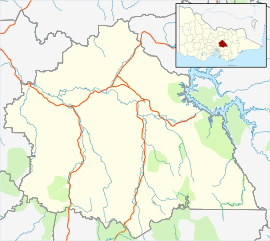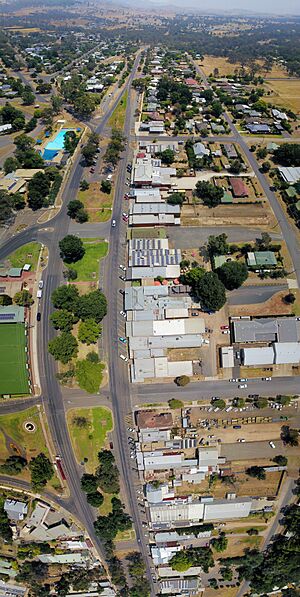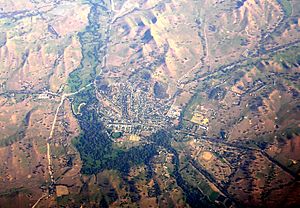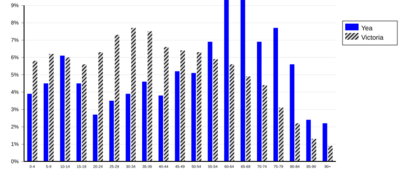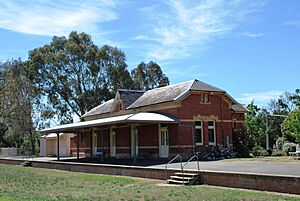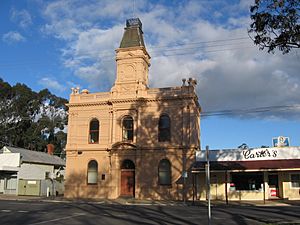Yea, Victoria facts for kids
Quick facts for kids YeaVictoria |
|||||||||||||||
|---|---|---|---|---|---|---|---|---|---|---|---|---|---|---|---|
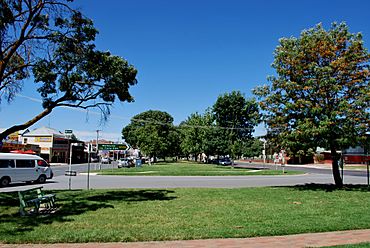
High Street, Yea
|
|||||||||||||||
| Population | 1,789 (2021 census) | ||||||||||||||
| • Density | 10.090/km2 (26.13/sq mi) | ||||||||||||||
| Established | 1855 | ||||||||||||||
| Postcode(s) | 3717 | ||||||||||||||
| Elevation | 172 m (564 ft) | ||||||||||||||
| Area | 177.3 km2 (68.5 sq mi) | ||||||||||||||
| Time zone | AEST (UTC+10) | ||||||||||||||
| • Summer (DST) | AEDT (UTC+11) | ||||||||||||||
| Location |
|
||||||||||||||
| LGA(s) | Shire of Murrindindi | ||||||||||||||
| County | Anglesey | ||||||||||||||
| State electorate(s) | Eildon | ||||||||||||||
| Federal Division(s) | Indi | ||||||||||||||
|
|||||||||||||||
|
|||||||||||||||
Yea (pronounced "YAY") is a town in Victoria, Australia. It's about 112 kilometers (70 miles) north-east of Melbourne. You can find it where the Goulburn Valley Highway and the Melba Highway meet. This area is part of the Shire of Murrindindi.
Long ago, the Taungurung people lived in this area. European explorers first visited in 1824. Within 15 years, most of the land was used by farmers who raised animals (called graziers). Yea was officially mapped out in 1855. The town grew as a place to support farming, gold-mining, and timber-getting (cutting down trees for wood).
Yea's population has been quite steady since 1900, around 1,100 people. Today, it has a slightly older population. The town's economy mainly helps local farms and welcomes tourists. It has good roads but not much public transport. Yea has three schools: a state primary, a state high school, and a Catholic primary school. There are also three churches and active sports clubs.
Important historical places in Yea include the old railway station buildings and Purcell's General Store. This store was run by the same family for about 100 years. Nearby, you can visit the Yea Flora Fossil Site. Here, scientists found the oldest leafy plant fossils ever discovered on Earth!
Contents
History of Yea
The land around Yea was originally home to the Taungurung people. They called the Yea River "Caluther" and the Goulburn River "Warring." Before Europeans arrived, their numbers had already dropped due to diseases. When settlers came, their hunting grounds were destroyed by new animals and farms. This caused their population to decrease quickly.
The first Europeans to explore the area were William Hovell and Hamilton Hume. They crossed the Goulburn River in December 1824. The next day, they crossed a stream they called "Muddy Creek." This creek was later renamed the Yea River in 1879. They said the land was good for grazing animals. However, the forests were very thick and hard to get through.
European Settlement in Yea
The first European settlers arrived in 1837 from New South Wales. By 1839, most of the good land was taken for farming. The crossing at Muddy Creek became a busy spot. It was part of the route from Melbourne to the goldfields.
A blacksmith set up a shop and home at the crossing. Because of this, a town was planned and mapped out in 1855. It was named Yea after Colonel Lacy Walter Giles Yea. He was a British Army officer who died in a war that same year. Town lots were sold in 1856. The Post Office opened in 1858.
How Yea Grew Over Time
Yea grew a lot when people came looking for gold in the late 1850s. It was a natural place for travelers to stop overnight on their way to other goldfields. Gold was found in areas near Yea, like the 'Providence' diggings and Ti Tree Creek. However, most of these gold mines were not profitable for long. The main mines closed by the 1890s.
After gold mining ended, Yea continued to support farming and timber cutting. Wood was mainly taken from the Murrindindi forests. The timber industry was very busy from 1907 to 1915. It boomed again from 1923 to 1930. During these times, a lot of timber was sent out each year.
The Yea Dairy Company started in 1891. Dairy farms around the area helped local farmers earn more money. A lot of butter was sent to Melbourne.
There was a plan in 1908 to build a water scheme that would have flooded the town. This made property values drop. However, the plan was stopped before it was finished. Another site at Eildon was chosen instead.
Fires and Floods in Yea
Yea has often been affected by bushfires and floods. Explorers even wrote about fires when they first visited. Floods regularly affected the roads. In 1884, the area had both a flood and a fire. On New Year's Day in 1900, celebrations were canceled to fight a fire around the town. In 1969, the town had to be defended from fires on all sides.
Later Years in Yea
The Yea Magistrates' Court, which handled local legal cases, closed in October 1989.
Geography of Yea
| Weather chart for Yea | |||||||||||||||||||||||||||||||||||||||||||||||
|---|---|---|---|---|---|---|---|---|---|---|---|---|---|---|---|---|---|---|---|---|---|---|---|---|---|---|---|---|---|---|---|---|---|---|---|---|---|---|---|---|---|---|---|---|---|---|---|
| J | F | M | A | M | J | J | A | S | O | N | D | ||||||||||||||||||||||||||||||||||||
|
11
29
11
|
39
29
12
|
42
26
9
|
49
21
6
|
57
16
4
|
60
12
3
|
60
12
3
|
65
14
3
|
63
17
4
|
61
20
6
|
54
24
8
|
47
27
10
|
||||||||||||||||||||||||||||||||||||
| temperatures in °C precipitation totals in mm source: Bureau of Meteorology |
|||||||||||||||||||||||||||||||||||||||||||||||
|
Imperial conversion
|
|||||||||||||||||||||||||||||||||||||||||||||||
Yea is located on a bend in the Yea River. It's about 5 kilometers (3 miles) south-east of where the Yea River meets the Goulburn River. The town is 112 kilometers (70 miles) north-east of Melbourne. It sits 172 meters (564 feet) above sea-level.
The center of Yea is on the Yea River's flood plain. However, the homes to the south are built on the slopes of nearby hills. The Goulburn Valley Highway (B340) goes through the town. The Melba Highway (B300) from Melbourne's eastern suburbs ends here. Another way to Melbourne is via the Yea-Whittlesea road (C725).
Yea's main buildings, like shops and public places, are along the Goulburn and Melba Highways. Most homes are to the south of the town center. Newer housing areas have been built to the west. The homes are mostly single-story houses on their own blocks of land.
The land around Yea is mainly used for farms. Farmers raise beef cattle and sheep.
Plants and Animals in Yea
There are no original native plants left right around Yea. The area used to have grassy woodlands with River Red Gum trees. In the valleys and hills, there were forests with Acacia and Box Eucalyptus trees.
The Yea Wetlands is a large area of 32 hectares (79 acres) just east of town. It's located between two parts of the Yea River. A lot of work has been done to bring back the native plants here. This site is one of only six places where the rare ancient greenling damselfly has been found. However, no damselflies have been seen there since 2001.
Local Government in Yea
The first local government in the area was the Yea District Road Board, started in 1869. This became the Shire of Yea in 1873. Even with money problems and the high cost of fixing roads after fires and floods, the shire built important public facilities. They also successfully pushed for better transport and communication links.
In 1994, the Shire of Yea became part of the Shire of Murrindindi. This was part of a big change to local governments in Victoria. The town of Yea is now in the Cheviot Ward of the Murrindindi Shire.
Population of Yea
In 2021, the town of Yea had 1,789 people. Records show that Yea's population has been quite steady since the early 1900s. The number of homes, however, has doubled in the same time. Yea has a higher number of older people compared to the average. Only about half of the people over 15 years old work.
Economy of Yea
Since it started, Yea has been a town that supports the farming and resource industries nearby. This includes raising animals for meat and wool. Before 1900, gold mining was important. From then until the late 1900s, timber cutting and dairy farming were key. The Yea Dairy Factory opened in 1891 and closed in 1993. Other factories or manufacturing have never been very big in Yea.
Yea's shops still serve the local farms. However, more than half of the shops now sell food or offer food services. The Yea Saleyards is a major place for selling livestock (farm animals) in Central Victoria. Sales happen at least once a month.
Transport in Yea
The local government groups, the Yea District Road Board and the Shire of Yea, made big improvements to transport. They built bridges at Molesworth (1874) and King Parrot Creek (1872). They also successfully pushed for a rail line from Tallarook, which opened in 1883.
The railway line was extended to Molesworth in 1889. This was mainly to transport timber to Melbourne. The last train for passengers ran on May 28, 1977. The line fully closed on November 18, 1978. The old railway line from Tallarook to Mansfield is now a walking and cycling path called the Great Victorian Rail Trail.
Now that the train service is gone, public transport in Yea is limited. There's a V/Line bus service to Melbourne or Mansfield twice a day. There's also a bus from Alexandra to Seymour via Yea once a day on weekdays. The Seymour train line is only 30 minutes away by car. It offers frequent train services to Melbourne.
Religion in Yea
People probably started having private religious services in Yea before the 1850s. The first public services likely began in the 1850s. In 1857, the Muddy Creek Mission was formed. They arranged for an Anglican preacher. The building they provided was meant for "Evangelical Christianity" for all Protestant churches. A church, originally meant to be Baptist, was taken over by the Presbyterian Church in the mid-1860s. The current Presbyterian church opened in 1923.
St Luke's Anglican church opened in 1868. The Catholic Sacred Heart Church opened in 1902.
Education in Yea
Yea's high school is Yea High School. The school also manages the Access Yea Community Education Program (AYCE). This program helps students who have left school or don't fit into the regular school system. The Yea Primary School and the Catholic Sacred Heart Parish Primary School teach students at the primary level.
Sports in Yea
The earliest record of a cricket match in Yea is from January 1869. A formal cricket club seems to have started in 1872.
An early lawn tennis match between Yea and Alexandra happened in June 1891. It was a big event because it was the first time the local club played against a team from another town. A petition in the same year asked for land to be set aside for tennis. It said the land had been used by the Tennis Club for years.
Signs at the town entrances say Yea is the birthplace of Olympic horse rider Bill Roycroft. However, he was actually born in Melbourne and grew up in Flowerdale.
The Yea Football Netball Club manages football and netball in the town. Senior teams play in the Yarra Valley Mountain District Football and Netball League. Junior teams play in the Seymour District Junior Football Netball League. The senior netball teams have been very successful recently. Because the town is a bit isolated, the Tigers (the club's nickname) have played in many different leagues.
The Yea Racing Club holds three horse race meetings each year. The Yea St Patrick's Racing Club also has a picnic race meeting at the Yea racecourse every year.
Golfers can play at the Yea Golf Club on Racecourse Road.
Landmarks and Historical Sites in Yea
Yea has several buildings listed on the Victorian Heritage Register. The former Yea railway station is a great example of old Gothic-style railway buildings. It was built in 1889. Today, a community group manages it. It's used for community events, including a monthly country market.
The former Purcells General Store is one of the oldest buildings still standing in Yea. The Purcell family owned and ran a store in the town from the 1860s until 1986.
Other important buildings on the register include the old Yea & Mansfield Dairy Co Ltd building (1891) in Rattray St. Also, the Yea Shire Hall (1877), the RSL Hall, and the Yea Memorial Hospital (1945) are listed.
The Yea Flora Fossil Site on Limestone Road is on the Australian National Heritage List. This is because scientists found the oldest leafy plant fossils ever discovered on Earth there.


